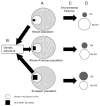The HLA-DRB1 shared epitope is associated with susceptibility to rheumatoid arthritis in African Americans through European genetic admixture
- PMID: 18240241
- PMCID: PMC3726059
- DOI: 10.1002/art.23166
The HLA-DRB1 shared epitope is associated with susceptibility to rheumatoid arthritis in African Americans through European genetic admixture
Abstract
Objective: To determine whether shared epitope (SE)-containing HLA-DRB1 alleles are associated with rheumatoid arthritis (RA) in African Americans and whether their presence is associated with higher degrees of global (genome-wide) genetic admixture from the European population.
Methods: In this multicenter cohort study, African Americans with early RA and matched control subjects were analyzed. In addition to measurement of serum anti-cyclic citrullinated peptide (anti-CCP) antibodies and HLA-DRB1 genotyping, a panel of >1,200 ancestry-informative markers was analyzed in patients with RA and control subjects, to estimate the proportion of European ancestry.
Results: The frequency of SE-containing HLA-DRB1 alleles was 25.2% in African American patients with RA versus 13.6% in control subjects (P = 0.00005). Of 321 patients with RA, 42.1% had at least 1 SE-containing allele, compared with 25.3% of 166 control subjects (P = 0.0004). The mean estimated percent European ancestry was associated with SE-containing HLA-DRB1 alleles in African Americans, regardless of disease status (RA or control). As reported in RA patients of European ancestry, there was a significant association of the SE with the presence of the anti-CCP antibody: 86 (48.9%) of 176 patients with anti-CCP antibody-positive RA had at least 1 SE allele, compared with 36 (32.7%) of 110 patients with anti-CCP antibody-negative RA (P = 0.01, by chi-square test).
Conclusion: HLA-DRB1 alleles containing the SE are strongly associated with susceptibility to RA in African Americans. The absolute contribution is less than that reported in RA among populations of European ancestry, in which approximately 50-70% of patients have at least 1 SE allele. As in Europeans with RA, the SE association was strongest in the subset of African American patients with anti-CCP antibodies. The finding of a higher degree of European ancestry among African Americans with SE alleles suggests that a genetic risk factor for RA was introduced into the African American population through admixture, thus making these individuals more susceptible to subsequent environmental or unknown factors that trigger the disease.
Figures



Comment in
-
Admixed populations and autoimmunity.Arthritis Rheum. 2008 Feb;58(2):335-7. doi: 10.1002/art.23192. Arthritis Rheum. 2008. PMID: 18240252 No abstract available.
References
-
- Brighton SW, de la Harpe AL, van Staden DJ, Badenhorst JH, Myers OL. The prevalence of rheumatoid arthritis in a rural African population. J Rheumatol. 1988;15:405–8. - PubMed
Publication types
MeSH terms
Substances
Grants and funding
LinkOut - more resources
Full Text Sources
Medical
Molecular Biology Databases
Research Materials

